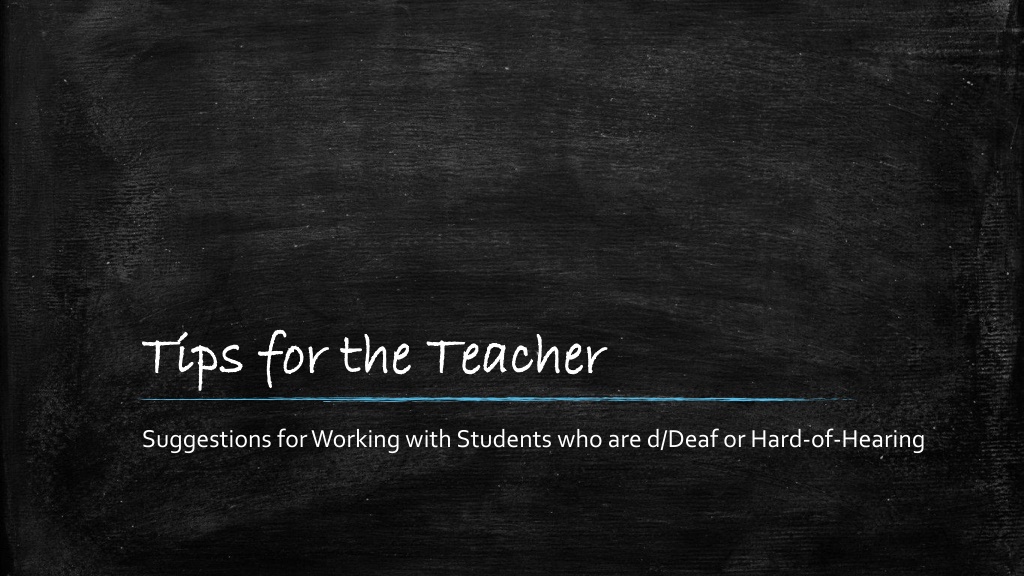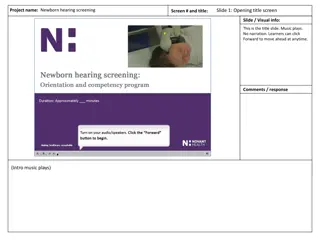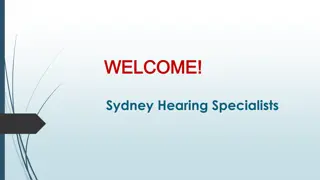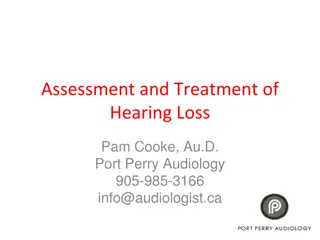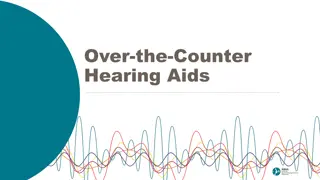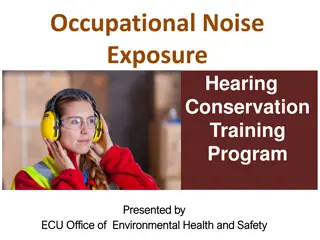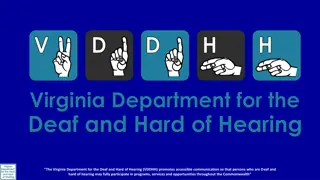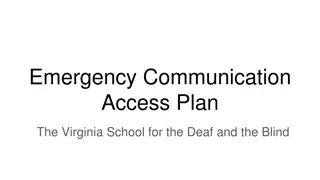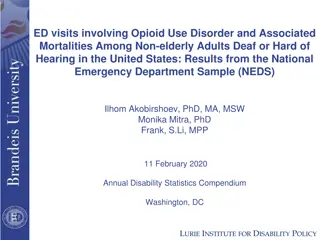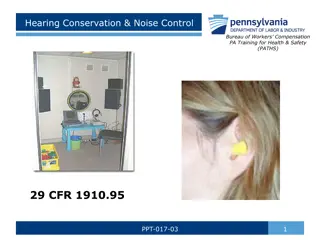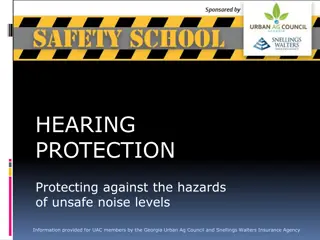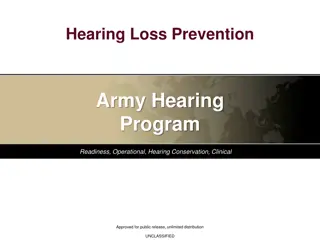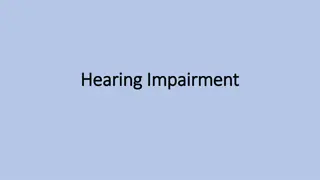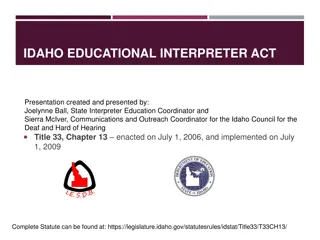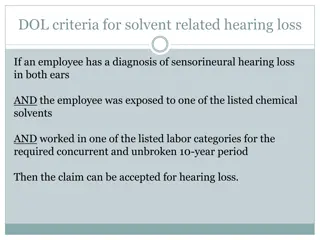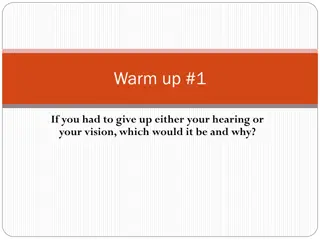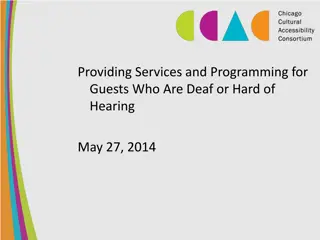Effective Strategies for Supporting Deaf or Hard-of-Hearing Students
Explore valuable tips for teachers working with students who are deaf or hard of hearing, including environmental recommendations like flexible seating and minimizing noise distractions. Discover teaching modification suggestions such as gaining attention, using visuals, and facilitating participation to enhance the learning experience for these students.
Download Presentation

Please find below an Image/Link to download the presentation.
The content on the website is provided AS IS for your information and personal use only. It may not be sold, licensed, or shared on other websites without obtaining consent from the author. Download presentation by click this link. If you encounter any issues during the download, it is possible that the publisher has removed the file from their server.
E N D
Presentation Transcript
Tips for the Teacher Tips for the Teacher Suggestions for Working with Students who are d/Deaf or Hard-of-Hearing
Tips for the Teacher Tips for the Teacher Learning Target: I will be able to support the learning and achievement of a student who is d/Deaf or hard-of-hearing by adapting the classroom environment, modifying teaching strategies, and collaborating with resource personnel and parents.
Environmental Recommendations Environmental Recommendations Flexible, preferential seating Away from extraneous noise Visible face Daily routines and schedules
Flexible, Preferential Seating Flexible, Preferential Seating
Away from Extraneous Noise Away from Extraneous Noise Hall noise Street noise Pencil sharpeners Air conditioning/heating vents Example: background noise in a classroom
Visible Face Visible Face
Daily Routines and Schedules Daily Routines and Schedules Post learning targets, schedules, and agendas Assignment board Mark transitions
Teaching Modification Recommendations Teaching Modification Recommendations Gain attention Give effective directions Use visuals Facilitate participation: Large group Small group Independent
Teaching Modification Recommendations Teaching Modification Recommendations Check comprehension Rephrase and restate Avoid divided attention Monitor effort
Gain Attention Gain Attention Gain attention first. Use an attention signal. Call student by name.
Give Effective Directions Give Effective Directions Remain in one place. Use visual cues. Keep them brief. Write down the steps.
Use Visuals Use Visuals Use diagrams or illustrations. Write down directions. List vocabulary Post examples Model
Facilitate Participation Facilitate Participation large Group large Group Support localization. Restate student responses or questions
Facilitate Participation Facilitate Participation Small Group Small Group Quieter setting? Leave the assistive listening device with the small group. Support localization.
Facilitate Participation Facilitate Participation Independent Independent Quieter setting? Allow student to subvocalize. Turn off or mute the transmitter
Check for Comprehension Check for Comprehension Ask open-ended questions. Ask, What did you learn? Avoid yes/no questions.
Rephrase and Restate Rephrase and Restate Encourage self-advocacy. Repeat questions once, then rephrase. Substitute simpler vocabulary. Simplify grammar. Give choices
Avoid Divided Attention Avoid Divided Attention Ask student to listen first. Provide outline or notes.
Monitor Effort Monitor Effort Quicker to fatigue when listening Short, intensive periods of instruction Alternate activities.
Collaboration Collaboration Work with resource personnel Work with parents
Work with Resource Personnel Work with Resource Personnel Vocabulary Assigned readings
More on Vocabulary More on Vocabulary
More on Vocabulary More on Vocabulary
Work with Parents Work with Parents Assigned readings Vocabulary list
Schedule Changes! Schedule Changes! We want to and can be flexible with your classroom and schedules! However . Sudden or drastic changes cause a missed IEP service and a domino effect for staff changes. This includes classes not starting/ending on time (and vis versa for the TOD) When set schedules change throughout the year, this changes schedules for teachers of the deaf, paras, interpreters, related service providers and can cause another student to be without a service they require. Please try to keep to the set basic schedule and/or let us know as soon as possible ahead of the change so we can work according to meet student need.
The Assistive Listening Devices The Assistive Listening Devices Most students on FM device Remember to charge each afternoon before leaving school! Where do I wear the mic? The mute button! How/When do I sync? Where is the student equipment kept? Changing to the Roger .More to come later!
Paras in the Classroom A supplementary aid/service outlined on the IEP for a designated amount of minutes/specific class In the classroom to support a student for a reason considered on the IEP (language support, vocabulary support, understanding and following directions in a larger group setting, support with a specific area/skill) Can supervise students, but are not in the classroom to teach instruction; rather present to support teacher instruction for a specified student Are welcome to open conversations about classroom expectations
Interpreters in the Classroom American Sign Language Interpreters provide equal access to language Interpreters voice anything the student signs and sign anything any other student would be able to hear. Please recall that interpreters cannot supervise students. Are welcome to open conversations about classroom expectations See handout for more helpful information.
Thank you!! Please come to us at any time with any questions you have. We are always available to support with a student/trouble shoot a device. We have teacher tips available if you d every like more ideas on working with a student/additional information on best working with students who are deaf or hard of hearing.
